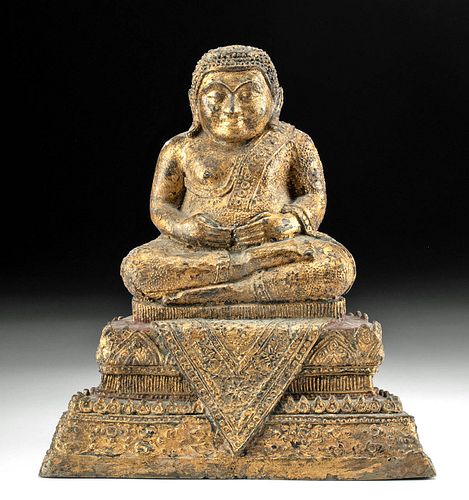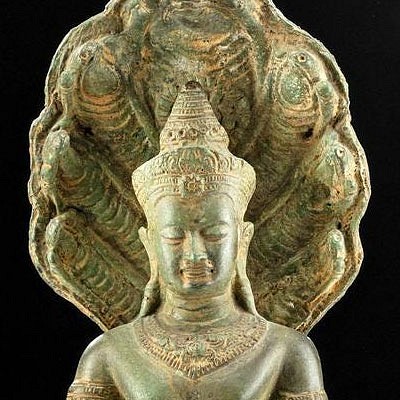19th C. Thai Gilt Brass Sankachai Buddha, ex-Museum
Lot 83
About Seller
Artemis Fine Arts
686 S Taylor Ave, Ste 106
Louisville, CO 80027
United States
Selling antiquities, ancient and ethnographic art online since 1993, Artemis Gallery specializes in Classical Antiquities (Egyptian, Greek, Roman, Near Eastern), Asian, Pre-Columbian, African / Tribal / Oceanographic art. Our extensive inventory includes pottery, stone, metal, wood, glass and textil...Read more
Categories
Estimate:
$800 - $1,200
Absentee vs Live bid
Two ways to bid:
- Leave a max absentee bid and the platform will bid on your behalf up to your maximum bid during the live auction.
- Bid live during the auction and your bids will be submitted real-time to the auctioneer.
Bid Increments
| Price | Bid Increment |
|---|---|
| $0 | $25 |
| $300 | $50 |
| $1,000 | $100 |
| $2,000 | $250 |
| $5,000 | $500 |
| $10,000 | $1,000 |
| $20,000 | $2,500 |
| $50,000 | $5,000 |
| $100,000 | $10,000 |
| $200,000 | $20,000 |
About Auction
By Artemis Fine Arts
Aug 10, 2021
Set Reminder
2021-08-10 12:00:00
2021-08-10 12:00:00
America/New_York
Bidsquare
Bidsquare : Museum-Deaccession | Asian & Pre-Columbian
https://www.bidsquare.com/auctions/artemis-gallery/museum-deaccession-asian-pre-columbian-7316
An interesting mix of de-accessioned Asian and Pre-Columbian Art from The Ashland University Museum in Ashland, OH, originally donated between 1994 to 1998. All lots from the Museum have been noted, as such. Artemis Fine Arts info@artemisgallery.com
An interesting mix of de-accessioned Asian and Pre-Columbian Art from The Ashland University Museum in Ashland, OH, originally donated between 1994 to 1998. All lots from the Museum have been noted, as such. Artemis Fine Arts info@artemisgallery.com
- Lot Description
Southeast Asia, Thailand, ca. 19th to early 20th century CE. A charming brass statue of the Buddhist monk Phra Sankachai on an integral three-tiered pedestal and painted with red lacquer and gilt. The tall pedestal is ornately cast with a corner of a patterned cloth hanging down the front. Phra Sankachai (Songachai, Sangkachai, or Ho Tai in Chinese) is often known as the Happy Buddha, intended to bring good fortune to worshipers. He sits in full lotus position with his hands resting on his rather rotund stomach. He presents a jovial countenance with his smile and rounded features. His ears are elongated, and his coiffure is made up of individual nodules. Sankachai is not a historical Buddha; instead, he represents a revered Chinese Monk who was famous for his Buddhist sermons and renowned for his beauty. To avoid the unwanted attention of women, he became overweight. This gilt painted figure is the perfect symbol of good fortune and wealth! On the verso are two integral rings for securing him in a public temple. Size: 8" L x 5.5" W x 9" H (20.3 cm x 14 cm x 22.9 cm)
Provenance: ex-Ashland University Museum, Ashland, Ohio, USA, donated to Ashland University between July 1994 to December 1998
All items legal to buy/sell under U.S. Statute covering cultural patrimony Code 2600, CHAPTER 14, and are guaranteed to be as described or your money back.
A Certificate of Authenticity will accompany all winning bids.
PLEASE NOTE: Due to recent increases of shipments being seized by Australian & German customs (even for items with pre-UNESCO provenance), we will no longer ship most antiquities and ancient Chinese art to Australia & Germany. For categories of items that are acceptable to ship to Australia or Germany, please contact us directly or work with your local customs brokerage firm.
Display stands not described as included/custom in the item description are for photography purposes only and will not be included with the item upon shipping.
#166376Chipping and losses to gilt. Chips to high pointed areas and surface abrasions. Light mineral deposits. Old brick infill in base from when the statue was attached to an architectural element.Condition
- Shipping Info
-
All shipping is handled in-house for your convenience. Your invoice from Artemis Gallery will include shipping calculation instructions. If in doubt, please inquire BEFORE bidding for estimated shipping costs for individual items.
-
- Buyer's Premium



 EUR
EUR CAD
CAD AUD
AUD GBP
GBP MXN
MXN HKD
HKD CNY
CNY MYR
MYR SEK
SEK SGD
SGD CHF
CHF THB
THB













